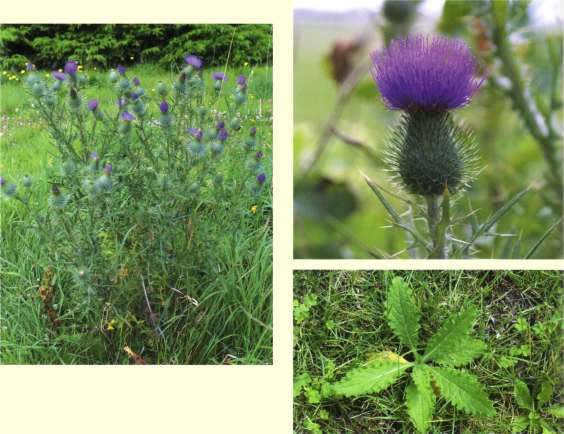|
 An
Illustrated Guide to An
Illustrated Guide to
Common Weeds
of New Zealand
Cirsium
vulgare
Scotch
thistle
Family
ASTERACEAE
Reproduced from
Common
Weeds of New Zealand
by Ian Popay, Paul Champion & Trevor James
ISBN 0 473 09760 5
by kind permission of the
New
Zealand Plant Protection Society
Publication or other use of images or descriptive
text on these pages is unauthorised unless written permission is
obtained from the authors and publisher.
Appropriate acknowledgement
of the publication Common Weeds of New Zealand must always
be given.
Available from Nationwide Book Distributors
Stout, well-branched
biennial thistle that grows from a rosette that can be very large,
to a well-branched 'shrub' up to 1.5 m tall under fertile conditions.
Composite flower heads up to 5 cm across, purple-coloured, later
producing seeds with a mass of pappus hairs or thistledown. Leaves
are hairy on both surfaces, and have spines on the upper surface.
Probably the most common thistle in New Zealand.
- Flowers
Reddish-purple, up to 6 cm long by 5 cm across, solitary or in
two- or three-flowered terminal clusters. Outer bracts (small
green, leaf-like structures forming the outside of the flower
heads) slightly woolly-hairy, each with a strong spine about 4
mm long. Flowers Nov-Mar.
- Fruit
Narrow, egg-shaped, pale achenes about 4 mm long by 1.5 mm across,
each with a feathery pappus 20-25 mm long.
- Leaves
Dark green, to 30 cm long by 10 cm wide, prickly-hairy on upper
surface, white-cottony on underside. Deep lobes tipped with strong
spines. On flowering stem, lower leaves are stalked and those
further up are stalkless.
- Stems
Stout, erect, furrowed, branched, with spiny wings.
- Roots
Long fleshy taproot.
Habitat
Pasture, waste places,
arable land, disturbed forest and road-sides.
Distribution
Widespread throughout
New Zealand. Originally from Eurasia and north Africa.
Comments
One of the most abundant
thistles in NZ. In pasture it seems to be strictly a biennial,
germinating in winter or spring, surviving its first summer as
a rosette and then flowering in its second summer. It is rarely
eaten by sheep or cattle, but goats will graze it once it has
started to flower. Appears in very large numbers after fire or
soil disturbance. Subject to a Pest Plant Management Strategy
in one or more regions. Check with the regional council for details.
Related
species
The woolly-headed thistle
(Cirsium brevistylum) has wingless stems with cobwebby
hairs, leaves with woolly undersides, uncommon in grassland, river
flats and waste ground in southern NI.
Derivation
of botanical name
Cirsium Gr.
name for thistle; vulgare (Lat.) = common.
Web-notes:
Weed Links
On this site
Reproduced from Common Weeds
of New Zealand:
External Links
 Weedbusters
New Zealand Weedbusters
New Zealand
- Weedbusters is a weeds awareness and education programme that aims to
protect New Zealand's environment from the increasing weed problem.
- AgPest
- A free tool to assist farmers and agricultural professionals in decision-making regarding weed and pest identification, biology, impact and management.
 New Zealand Weeds Key New Zealand Weeds Key
- An interactive identification key to the weeds of New Zealand. Developed at Landcare Research.
New
Zealand Plant Conservation Network naturalised plants
- Search for information on more than 2500 naturalised and weedy plants.
 New
Zealand Plant Protection Society New
Zealand Plant Protection Society
- Their main objective: "To pool and exchange information on the biology
of weeds, invertebrate and vertebrate pests, pathogens and beneficial organisms
and methods for modifying their effects."
-
 Massey
University Weeds Database Massey
University Weeds Database- A site providing information about New Zealand weeds and weed control.
It has a series of pages showing pictures of New Zealand weeds, notes on
identification and control. It also provides information on a university
paper entitled Controlling Weeds.
-
-
More
Plant Profiles
|







